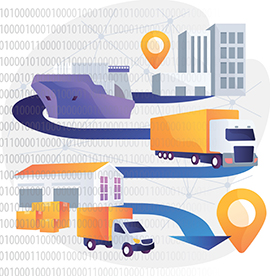As part of a classroom assignment at Harvard Business School in 1978, Dan Bricklin created the prototype for spreadsheet software. Not only did it make paper-based account ledgers with handwritten figures obsolete, but Steve Jobs credited Bricklin’s invention — dubbed VisiCalc (short for visible calculator) — with the success of the Apple IIe, the personal computer it shipped with. All because Bricklin excelled at homework. Now, some 40-odd years later, imagine trying to conduct business as efficiently without automated spreadsheets.

Editorial credit: CassielMx/Shutterstock.com
While money managers no longer use written ledgers, freight traveling the global supply chain still often requires paper documentation. Border agents, for example, demand truck drivers produce a printed manifest of their cargo.
“There’s a better way,” says TTI Research Scientist Juan Villa. “Digitizing data associated with products and processes can automate information exchange and minimize the need for human involvement. That increases efficiencies in the supply chain, and that helps everyone, from manufacturer to consumer.”
Villa is talking about blockchain technology. Blockchain refers to housing data in secure blocks and making it accessible through a chain of secured databases for eyes-only viewing by those who need to see it. Manufacturers, shippers, warehouse managers, customs agents, store managers and even consumers need information about where, when and how a product will make it to store shelves. Not all of them, however, need access to all the data. A shipper, for example, might want their costing structure kept private, away from the competition. Strong security measures also fence off data from potential bad actors, who could target dangerous cargo (e.g., hazardous materials) for use in acts of terrorism.
“That’s the security part,” Villa says, “but blockchain is also about automation. Currently, passing a shipping container through inspection at a port can be onerous.”
As part of its ongoing research into freight logistics and supply-chain optimization, TTI recently completed a project with the Port of Veracruz, the third busiest port in Mexico. By 2030, port authorities expect to more than quadruple the volume of freight passing through. To meet that demand, operate efficiently and attract shippers to use the port, Port of Veracruz stakeholders engaged TTI to help them develop a port community system (PCS) using blockchain technology. Phase I of the project focused on modeling and optimizing container exports.
Traditionally, when a container is flagged for inspection, the customs agency notifies a customs broker of the requirement. The broker calls the terminal operator, who moves the flagged container to a specific location. Assuming the container passes inspection, the customs agent notes the approval on paper, releasing the container for shipping. Depending on how long the process takes, the ship the container was destined for might, quite literally, have sailed already. The container then sits, maybe for weeks, until another vessel comes along headed to its destination.
With blockchain, the customs agent uses a smartphone app tied into the PCS, and many of the in-person, physical-movement stages of the process are automated. When the inspection notice is first entered into the PCS, the system sends the request to all parties involved in the process, expediting the procedure without compromising efficacy. Once passed, the container is craned aboard ship and off to its next port of call with minimal delay.
With the inspection process, algorithms use digitized data to trigger the next steps in the freight management process to optimize information exchange. In another example of how blockchain can expedite processes, smart contracts can replace human-based paper inventories and invoices, and be submitted via data entry to automate payments for truckers once cargo arrives safely at its destination.
“The search for productivity, efficiency and social benefits is a collaborative undertaking in the freight sector,” says Jorge Lecona Murillo, head of innovation for Hutchison Ports Mexico. “The blockchain project in Veracruz is the demonstration of how multiple parties — such as the port authority, the port community and research centers like TTI — can collaborate to promote the technological, economic and social development of a community.”
Reduced costs, minimal delays, optimized efficiency, expedited freight flow — all are readily achievable thanks to blockchain technology. However, implementation of blockchain is just the beginning, Villa says. As with spreadsheet technology, its widespread implementation can transform the way data are managed to track freight worldwide.
“There is an imperative behind embracing blockchain sooner rather than later,” Villa says. “To remain competitive against economic powerhouses like China and India, the United States must use every tool in its toolbox. And blockchain is one of the most powerful tools we have to lower production and distribution costs for industry and commodity costs for consumers.”


